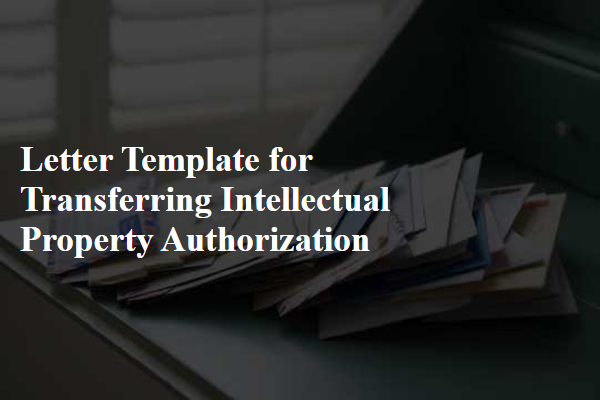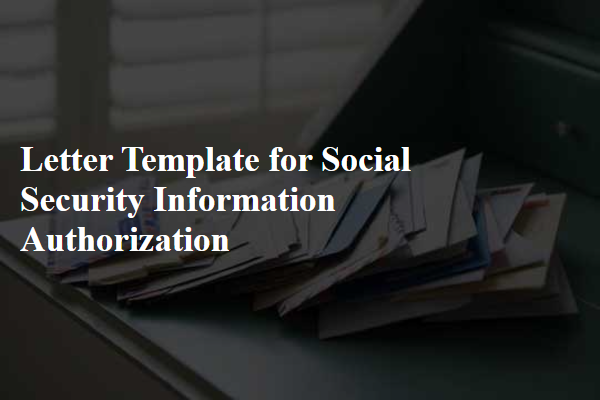Transferring intellectual property rights can seem daunting, but it's a crucial step in ensuring that your creative work is properly protected and utilized. Whether you're passing on rights to a colleague or selling your innovative ideas to a company, understanding the nuances of the authorization process is key. In this article, we'll break down the essential components of a transfer letter, highlighting important clauses and legal considerations. Join us as we explore how to craft an effective intellectual property transfer letter that safeguards your interests and paves the way for future collaborations!

Identification of Parties
The process of transferring intellectual property (IP) authorization often begins with identifying the parties involved in this legal transaction. The "Transferor," the individual or entity currently holding the rights to the intellectual property, must clearly be defined, including specific details such as the name, business address, and registration number if applicable. The "Transferee," the individual or entity acquiring the rights, should likewise be thoroughly detailed with their respective name, business address, and relevant identification numbers. This identification is crucial, particularly when dealing with intellectual property types such as patents, trademarks, or copyrights, where unique identifiers like patent numbers and trademark class codes play a significant role in establishing the legitimacy and scope of the transfer. Proper identification ensures that both parties are fully aware of their roles and responsibilities throughout the intellectual property transfer process.
Description of Intellectual Property
Intellectual property authorization is a legal framework that governs the permissions, rights, and responsibilities associated with creative works, inventions, or brand identities. In this context, examples include patents for inventions such as the innovative biodegradable packaging developed by EcoPack Solutions in 2022, trademarks like the iconic swoosh of Nike, or copyrights for artistic works like the bestselling novel "The Midnight Library" by Matt Haig. Proper documentation and legal procedures are crucial for transferring intellectual property rights from one entity to another. This transfer can include specific details regarding the scope of use, geographic limitations, and duration of the authorization granted to ensure clarity and protect the interests of both parties involved in the transaction.
Terms and Conditions
Transferring intellectual property (IP) authorization requires a comprehensive understanding of the involved terms and conditions. Intellectual property rights such as patents, trademarks, and copyrights encompass various legal protections that grant ownership and usage rights. The authorization document should clearly define the scope of the IP transfer, including specific descriptions of the IP assets, such as patents pertaining to technological innovations registered with the United States Patent and Trademark Office (USPTO) and trademarks associated with branding registered in the European Union Intellectual Property Office (EUIPO). Additionally, terms regarding duration of the authorization, geographic limitations, and usage rights must be precisely stated to avoid disputes. The document should also outline obligations related to confidentiality and responsibilities for infringement liabilities, ensuring mutual protection for both parties involved in the intellectual property transfer. Furthermore, any financial agreements regarding royalties or upfront payments as compensation for the IP must be clearly articulated, providing a transparent understanding of the financial aspects of the transaction.
Signatures and Date
Transferring intellectual property (IP) authorization involves officially transferring ownership rights of an invention, design, or trademark from one party to another. This process usually concludes with vital elements such as the signatures of both parties involved--the assignor (the original owner) and the assignee (the new owner)--and the date of the authorization transfer. These signatures validate the agreement and formalize the transaction. Essential details to include are the specific intellectual property being transferred--such as patent number, trademark registration details, or copyright registration--and terms governing the use of the IP. Proper documentation ensures legal enforceability, preventing future disputes over ownership rights.
Governing Law and Jurisdiction
Intellectual property authorization transfer discussions often require a clear understanding of governing law and jurisdiction. Typically, contracts specify the legal framework that governs the interpretation and enforcement of intellectual property rights, such as patents, trademarks, or copyrights, in a particular jurisdiction. For example, in the United States, the Uniform Commercial Code may apply, while international disputes might reference the World Intellectual Property Organization guidelines. Jurisdiction defines the geographical area where legal proceedings concerning the intellectual property can take place, ensuring that disputes are resolved in courts best suited for such matters. Clarity in these areas helps in mitigating conflicts and ensuring that all parties understand their rights and obligations under the applicable laws.
Letter Template For Transferring Intellectual Property Authorization Samples
Letter template of Intellectual Property Authorization Transfer Agreement













Comments